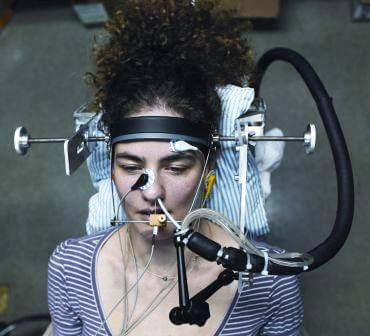The findings of the study, which is published in the journal Nature Neuroscience, show that there is a correlation between the neural response to a certain smell and the degree of pleasantness of that smell

The ability of certain smells to make us feel pleasure - or disgust - may seem like a minor matter of taste, but a new study by Weizmann Institute scientists shows that the degree of pleasantness of smells is the basic "scale" by which the perception of smell is organized. The findings of the study, published today in the journal Nature Neuroscience, show that there is a correlation between the neural response to a certain smell and the degree of pleasantness of that smell. This correlation allowed the researchers to determine whether a particular smell was pleasant or unpleasant for the subject - based on measurements made using an electrode inserted into the nasal cavity.
The sensory organs developed during evolution to encode sensory information in the best possible way, so their structure reflects an organizing "ladder". Thus, for example, vision is primarily a spatial sense, and therefore the organization of the retina represents coordinates that map the visible space. Hearing, on the other hand, is tonal, so the structure of the inner ear represents a scale of tones. In the field of smell, the situation is different: the perceptual scale according to which the sense of smell is organized is unknown, and scientists do not know how to point out the connection between the structure of the membrane responsible for smell, found in the nasal cavity, and the way we perceive a smell.
The attempt to decipher this connection was the focus of the research of the team of scientists led by Prof. Noam Sobel from the Department of Neurobiology at the Weizmann Institute of Science. The possibility that this is an organization based on the pleasantness of smells arose from the findings of research groups around the world, as well as from previous studies by Prof. Sobel, which showed that there is a connection between the chemical structure of a certain odorant and its degree of pleasantness. As a result, a hypothesis arose that the receptors responsible for sensing the smell in the nasal cavity - which include about 400 different subtypes - are arranged on the membrane according to some organizing principle, which represents the degree of pleasantness of the smell. This hypothesis stands in contrast to the accepted theory, according to which the receptors are randomly and uniformly distributed on the membrane.
To test the hypothesis, the scientists inserted an electrode through the nostril into the nasal cavity of the subjects, and measured the neural response created in response to different smells, at different locations on the membrane. Because
Continue on the next page >>>
>>> Continue from the previous page
- 2 -
The high density of the smell receptors is actually the nerve signal that is measured as the sum of the activity of thousands of different receptors. The results of the measurements showed that the strength of the nerve signal changes in different locations on the surface of the membrane. The researchers' conclusion was that the various receptors are not uniformly and randomly distributed, but grouped in complexes with a certain regularity, and each complex reacts to the strongest degree to a different smell. It was later discovered that a location that responded maximally to a pleasant smell tended to respond strongly to other pleasant smells as well, and vice versa: locations where a strong response to some unpleasant smell was measured, reacted strongly to the other unpleasant smells as well. That is, the law according to which the receptors are divided into the various complexes is the degree of pleasantness of smells.
Do the research findings really reflect what is happening in the real world? Prof. Sobel says that despite the fact that the smell in nature consists of a large collection of volatile molecules - rose flowers, for example, release 172 such molecules, the dominant one among them will determine which main area of the olfactory membrane will respond to the stimulus. The other materials will contribute to a secondary extent.
"We discovered a clear correlation between the pattern of the neural response to the smell, and the degree of pleasantness of the smells. As with vision and hearing, also with the sense of smell, the organization of the receptors on the surface reflects a basic perceptual axis," says Prof. Sobel. Another conclusion of the research findings is that the pleasure of smells is ingrained in us in advance, and is not individual. "However, it is possible that the olfactory complexes can undergo a reorganization, following personal and cultural connections or life experience. Such changes in the organization of the membrane, and of course also the processes of processing the sensory information that occur afterwards, create our personal experience in response to the smell."
The research was done by Dr. Hadas Lapid, Dr. Sagit Shoshan and Dr. Anton Plotkin from Prof. Sobel's group, in collaboration with Dr. Elad Schneidman from the Department of Neurobiology at the Weizmann Institute of Science, Dr. Yehuda Roth from the Wolfson Hospital in Holon, Prof. Hilary Pott from the Hebrew University in Jerusalem and Prof. Thomas Hummel from the University of Dresden in Germany.
